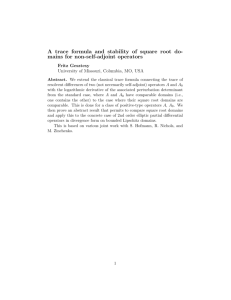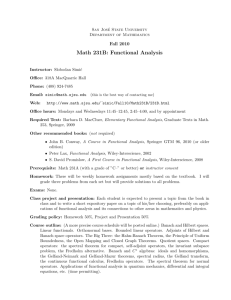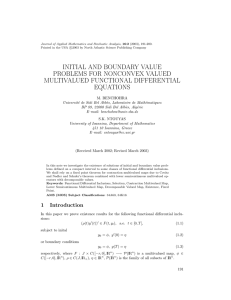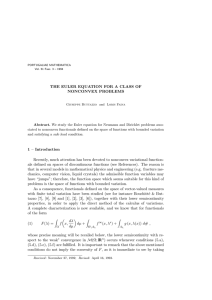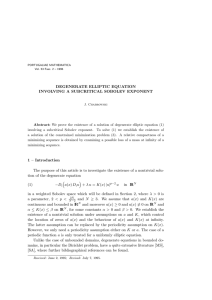[oc-POTENTIALS $CHRDINGER A "LOCALIZED"
advertisement
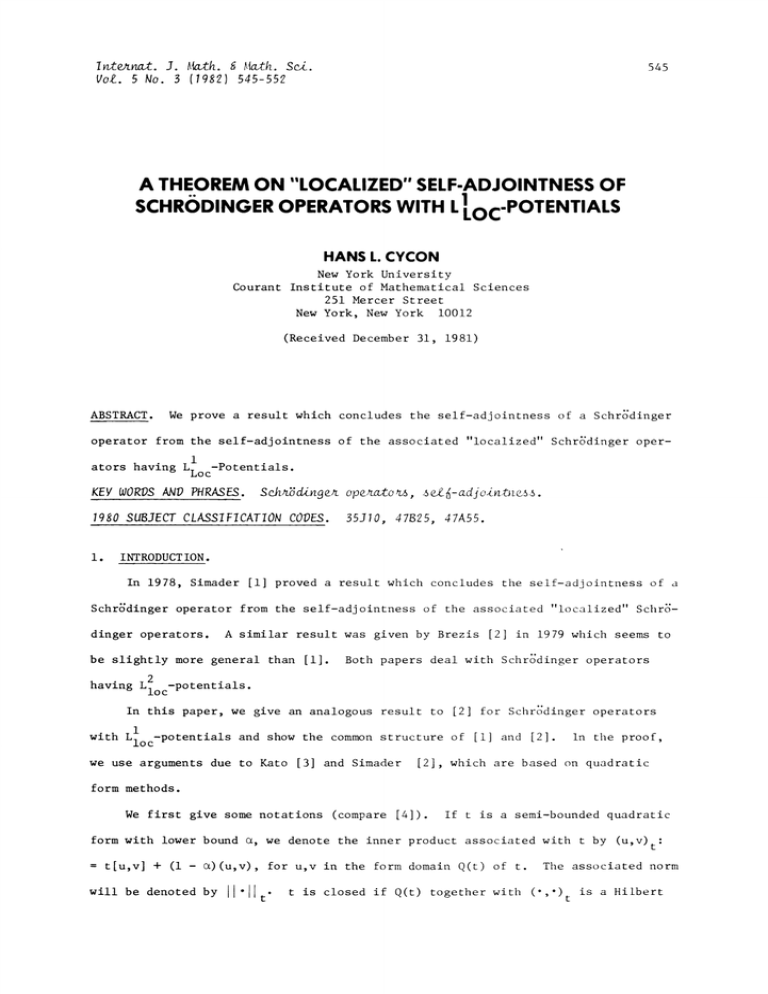
I nternat. J. ath. & ath. Sci.
Vol. 5 No. 3 (1982) 545-552
545
A THEOREM ON "LOCALIZED" SELF-ADJOINTNESS OF
$CHRDINGER OPERATORS WITH L
[oc-POTENTIALS
HANS L. CYCON
New York University
Courant Institute of Mathematical Sciences
251 Mercer Street
New York, New York 10012
(Received December 31, 1981)
ABSTRACT.
We prove a result which concludes the self-adjointness of a Schr6"dinger
operator from the self-adjointness of the associated "localized" Schr6"dinger oper-
1
ators having
LLoc-Potentials.
KEY WORDS AND PHRASES.
Schrdinger operators, self-adjontns.
1980 SUBJECT CLASSIFICATION CODES.
35J10, 47B25, 47A55.
INTRODUCT ION
1
In 1978, Simader [i] proved a result which concludes the self-adjointness of a
Schrdinger
operator from the self-adjointness of the associated "localized"
dinger operators.
Schr-
A similar result was given by Brezis [2] in 1979 which seems to
be slightly more general than [i].
Both papers deal with
Schrdinger
operators
2
having
Lloc-pOtentials.
In this paper, we give an analogous result to [2] for Schrdinger operators
with
1
Lloc-pOtentials
and show the common structure of [i] and [2].
we use arguments due to Kato [3] and Simader
[2], which
In the proof,
are based on quadratic
form methods.
We first give some notations (compare [4]).
form with lower bound
t[u,v] + (i
,
we denote the inner product associated with t by
)(u,v), for u,v in the form
will be denoted by
If t is a semi-bounded quadratic
ll’II t.
domain Q(t) of t.
t is closed if Q(t) together with
(u,v) t:
The associated norm
(’’’)t
is a Hilbert
H.L. CYCON
546
Recall the one-to-one correspondence between semibounded quadratic forms
space.
If T is a self-adjoint semibounded opera-
and semibounded self-adjoint operators.
tor, the domain of the closed form associated with T will be denoted by Q(T) and
the form by
<u,v>--> (Tu/v) for u,v
Q(T).
The associated norm will be called
We will always write Q(T) for the Hilbert space of the associ-
the form norm of T.
A set which is dense in the Hilbert space
ated form if the inner product is clear.
Q(T) will be called a form core of T.
Let q be a real-valued function on IR
n
and assume
e Iloc (IR n)
q
(c I)
and
Au + qu
Lu :=
D(L) := {u
with
L
2
(IRn)/qu
L
I
(.i)
n
foe
Then we define a
where the sum in (i.i) is taken in the distributional sense.
"maximal" operator
i
L2(IRn)
associated with L such that
Tmax u := Lu
(i.2)
with
D(T
max
:= {u
D(L)/Lu
2
L (IR n) }.
Consider the quadratic form associated with L
t[w,v] :=
Lv
w,v
C (IR n)
(i.3)
o
If we assume
t is bounded from below and closable (without loss of generality t->O),
then there exists a semibounded self-adjoint operator T
Note that for q
of t.
T
min
:= T
w,v
C
o
2
(n)
loc
C (IRn); see [3]
max
of the norm
L
II "If t
T
F
(C 2)
associated with the closure
with the Friedrichs extension of
F coincides
Q (TF) is then the closure of C (IR
n
in the sense
o
associated with the inner product
(w,v)t
:= t[w v] + (w,v);
(n).
From (C 2), we know
Co(n)
Now consider
T
with 0 _<
F
>
(1.4)
O.
< i such that
(x)
i for
Ixl
<_
i
and #(x)=O
for
For k
q,
let
k(X)
:= ( x ).
(1.5)
SELF-ADJOINTNESS OF SCHRODINGER OPERATORS
547
We now assume, for any k, there exists a "localized" operator associated with L;
for k
i.e.
(i)
there exist a
(C3)
:= {u
D(Lk)
with
such that
Au + qku
:=
LkU
I
L loc (IRn) and a
e
qk
L
2
(IRn)/qku
e L
I
loc
(IRn)
and
qku
qkku
(ii)
for
D(L).
u e
L2(IR n)
We define also a "maximal" operator in
:--
TkU
associated with
Lk;
i.e., for k e
LkU
(1.6)
with
D(T k) := {u
+
qk :=
Denote
L
n
()}.
is not really a restriction; see Corollary i and Corollary 2.
(C3)
Note, that
D(Lk)/u
2
{qk,0},
max
q
{-qk,0},
:= max
q
+ :=
q-
{q,0},
max
:= max {-q,0}.
MAIN RESULTS.
2.
THEOREM.
Let k e q.
in (1.2) and (1.6).
Assume r(C
I),
_(C
2), and _(C
3) and define
Tmax and Tk as
If we assume additionally,
T
k
(C 4)
is self-adjoint;
and
Co ( n)
is a form core of T
and there exists a c
k
k
>
0
(C 5
such that
(-Aw,w) +
then T
max
(qw/w) Ck[(TkW/W) + llwll 2 ],
_<
w
C(IR
n)o
(2.i)
is self-adjoint.
First we note that, by (C
PROOF.
5)
T
k
is bounded from below by -i.
Thus
Q(T k) is well defined.
Now we proceed in 5 steps.
Step i.
IN,
We show that for k
by (C
5) k u
e H
1
(n)
semiboundedness of T
By
HI(IR n)
:=
[3]),
(I IVul
2
+
D(Tk)
Iul 2)
Q(rk)
+
Q(qk
and
implies
qk u
e L
I
loc
ku
Q(T k), and thus,
(IR n) (making use of the
k)
we denote the closure of
1/2
n
D(Tma x)
u e
C(IR
n)
O
in the usual Sobolev norm
We have the continuous inclusions (compare Kato
Hl( n)
L2( n) H-l( n)
Q(T)*.
548
By
T
k
H.L. CYCON
H-I( n)
Q(Tk)* we denote the
2
D(Tk) onto L (IR n) and it
and
+ 2 maps
tended to a bicontinuous map T
+ 2
restriction of
v
to
Q(T k) implies qkv
+ 2
k
antidual spaces of
Hl( n)
Q(Tk).
and
is well known (see [4]) that this can be ex-
from Q(T
k)
onto
Q(Tk)*.
Actually
T
k
+2 isa
Q(T k) since, by (2.1) and the semiboundedness of Tk,
I
(IRn)" Now let u D(Tmax). Using (C3) we get in
L
loc
the distributional sense
2 V
LkkU kTmaxu
VSk u H-I(IR n)
L 2(IRn), we have
V u-
k
(2.2)
(Ak)U.
and all other terms on the right hand side of (2.2) are in
Since
LkkU H-I(IR n) Q(rk)*
Since T
+
k
2 is bijective, we conclude in the same way as Kato [3, Lemma 2] that
ku Q(Tk).
Step 2.
Let u
(C3)’
IN,
We show that, for k
From Step I, we know
D(Tmax)
D(Tmax)
u
n
I
H (
ku
implies
+ ).
Q(qk
n
Q(TF).
ku
Then, because of
we also have
k u Q(q+)o
From a theorem due to Simon [5, Theorem 2.1] (see also [6] for generalizations), we
know that
C(IR
n)
o
lwl
It+
is dense in
:=
I IVwl
2
HI(IRn)
+
(q+w/w)
Therefore, we can find a sequence {vn
lvn
SkUl It
Then, because of (1.4), we have
ku
(q (v
n
(2.3) and (2.4) imply
Step 3.
Q(Tk).
Q(TF)
implies
n in C o(IR n)
+->
Q(q
Then, because of
IN, v
ku
(C5)
in the sense of the norm
llw112} I/2,
+
kU)/(Vn_ kU)
Q(TF).
We show that, for k
u
Let v
ku
Q(q+)
n
0
w
H
I(n)
n
Q(q+).
such that
(n m> oo).
(2.3)
and
m> 0
Q(Tk)
(2.4)
(n--> oo).
implies
kv
Q(Tk) n
Q(TF)
and
(2.5)
Q(Tk).
there exists a sequence
Vn }nlq C(IR n)
in
such that
---> 0
denotes the form of T k.
(n > o),
(2.6)
SCHRDINGER
SELF-ADJOINTNESS OF
:= i + sup
For
[Vk[, we have
lVk(Vn-v) ll -< k{llv(vn-
v)
OPERATORS
ll
+
549
lvn-vII}
(2.7)
v)
(2.8)
and
qk
l*k(Vn
because of the semiboundedness of
(qkk(Vn-V)/k(Vn-V))
<
v)
Tk,
qk
](Vn
we have
llV,k(Vn-V) ll 2
+
f+qkl*k(Vn-V)
2
Ik(Vn
+
v)
ll 2
(2.9)
(2.9), together with (2.6), (2.7) and (2.8), yields
Q(T k)
kv
(2.10)
and
kVn kvl tk -->
Since, by
(C3)
we have
llkVn I12=t
(II’II t
(n --> oo).
0
2
-IIkVnll
IIkVnllmtk
denotes the form norm of
(n
q).
TF).
We can conclude
l@k(Vn Vm) IIt
--> 0
(n,m--> oo)
and thus
@kv Q(TF).
(2.11)
(2.10) and (2.11) prove the first part of Step 3.
Now, let u
D(T F) and v e
and there exist sequences
Q(TK).
{uj}jIN
luj ull t --> 0
and
and
Thus,
(TFU ,kv)
Using
(C3)
lid
j,m
{Vm }mlq
lvm
v
n
kv Q(Tk)
Then
in
lltk
(TFUj,kVm)
C(IRn)
--> 0
lid
Q(TF)
as proved above
such that
(j,m--> ).
(2.12)
(Luj,kVm)
we have
(Luj ,kVm
(LkkUj,vm)
2(uj,VkVVm)
(2.12) and (2.13) yields, for a suitable constant y
j-olim (kUj ,V)tk j-olim (TkkUj/v)
Thus the limit of
(TFU,kV)
{kUj}j1q exists weakly in
lkUj kUll --> 0
+
,
(uj ,VmAk).
2(u,VkVV)
+ y(u,v).
the Hilbert space Q(T
(j --> ),
(2.13)
k)
and since
550
H.L. CYCON
we conclude
k u Q(Tk),
which proves the second part of Step 3.
Step 4.
Let u e
We show T
D(TF).
T
F
max
Then, for k
from Step 3, we know
ku
Q(Tk)
and therefore, by
(C 5)
ku
I (IR n) n
Q
e H
(q).
As in Step i, we conclude that
L
qu
I
(IRn).
loc
Thus u e D(L) and, from
2
n
Lu e L (IR ),
TFU
we have
D(Tmax)_
u e
Step 5.
We show T
T
F
and
TFU
T
max
u.
max
In view of Step 4, we have to show
D
Let v e
D(Tmax)
(Tmax)
D (TF).
and
v’ := (T F +
Thus, v’ e
c_G_
D(Tma x)
i)-I (Tmax
+ l)v.
by Step 4 and
(T
max
+ l)v
(T F + l)v’
(Tmax + l)v’
With
u
we conclude (T
max
+ l)u
:= v- v’
D(Tmax)
0 and therefore
((Tmax
+ l)u,w)
We will show that (2.14) implies u
0
for
w
C(IRn).
o
0; then, Step 5 will be proven.
We argue in the following as Simander does in [i].
(C3)
Since T
max
is a real op-
From Step I, we know that
erator, we may assume u to be real-valued
and thus, by
(2.14)
ku
and the semiboundedness of
Ck u
If we replace w in (2 14) by
1
H (IRn) n
Tk,
Q(q+) n Q(q-).
we get, after some partial integrations,
Q(T k)
SCHRDINGER OPERATORS
SELF-ADJOINTNESS OF
(VkU,VkW)
+ (q
kU/kw)
(q
kU/kw)
+
((Vk)2u,w)
551
(kU,kw)
((uVw
wVu,kVk ).
(2.15)
Since
u e H
I
n
loc
(IR)
and
q+ lkU
1
L (IR n)
(2.15) by u
we can, by using an approximation, replace w in
(m)
e
i
Hlo c (IR n)
n
e (IR n)
defined by
u
I
(m)
.
for m
u(x)
for
m sign(u(x))
for
lu(x)
lu(x)
m
> m
Then, the limits of both sides of (2.15) exist and we get
(VkU,VkU)
+
(q+kU/ku) (q-kU/ku)
+
((Vk)2U,k u)
Since, from Step 2, we know
lkU 12
Thus u
_<
((r F +
(kU,k u)
+ ((UVk-kVU),kVk).
ku e Q(TF),
we conclude from (2.16) and from
l)kU/kU
RHS of (2.16) --> 0
(2.16)
TF+I>-I
that
(k --> oo).
0, which proves Step 5.
Since T
5, the theorem is proven.
is self-adjoint by Step
F
COROLLARY i.
IN.
Let k
Assume (C l) and
q-(x)
if
0
if
qk (x) :=
(C2).
Ixl
Ixl
Set
+
+
qk := q
-< k
> k
+
qk := qk- qk
and define T
k
and
Tmax as
in (1.6) and (1.2).
T
k
Assume additionally
(C
is self-adjoint
4
and
there exist 0
(qw/w)
Then T
max
-<
a
k
ak(-Aw,w
< 1 and b
+
k
bkl lwl 12
e 0 such that
w e
(C 5)
C(IR
n)
o
(2.17)
is self-adjoint.
PROOF.
(C3)
holds trivially.
(-Aw w) +
which implies (2.1).
(qw/w)
Since
<
C(IR
n)
o
From (2.17), we deduce
i
{(rkw/w
is dense in
+ (b k + i)
HI(IR n)
n
Q(q+)
lwl 12
in the sense of the
H.L. CYCON
552
I’l
norm
It+
(as we know from [5], see Step 2 above), (2.17) implies that
is a form core of T
of T
max
Therefore,
k.
holds and, by the theorem, self-adjointness
follows.
L21oc(IRn)’
Note that, for q
since then T
T
mln
COROLLARY 2.
Let k
Then T
k
and T
In the case q
L
2
loc
same arguments as above.
and if q
:= T
Assume
Co( n)
(C1) and (C2).
max
{ q(X)o
:=
as in (1.6) and (1.2).
max
is self-adjoint.
max
min
IN.
qk(x)
and define T
Corollary 1 implies the result of Sirder [1]
where
max
T
Kato’s [3]
variant of
Kato’s
if
Assume additionally
(C4)
and
(C5)
The proof follows immediately from the theorem.
(n)
Corollary 2 implies the result of
We also should note that, if
+
qk
+
q
and
Brzis [2]
qk
q
by the
(k e )
(-A + q +) with bound < i, our
result for the semibounded case.
proof of his main theorem in
On leave from:
Set
Ixl Xl -<> k
if
is form-bounded relative to the form of
theorem is
Note:
(C5)
C(IR
n)o
In fact, our proof is a
[3].
Technische Universtitt Berlin, Fachbereich Mathematik
StraBe des 17 Juni 135, 1 Berlin 12, Germany
REFERENCES
I.
SIMADER, C.G. Essential self-adjointness of Schrdinger operators bounded
from below, Math. Z. 159 (1978), 47-50.
2.
BRZIS,
3.
KATO, T.
H. "Localized" self-adjointness of SchrSdinger operators, J. Operator
Theory i (1979), 287-290.
A second look at the essential self-adjointness of Schrdinger operators, in: Physical reality and mathematical description, C.P. Enz, J.
Mehra eds., D. Reichel Dordrecht (1974).
.
4.
FARIS, W.G.
5.
SIMON, B
6.
CYCON, H.L.
Self-adjoint operators, Lect. Notes in Math. 433, Springer (1975).
Maximal and minimal
Schrdinger operators and forms,
i__ (1979), 37-47.
J.
Operator
On the form sum and the Friedrichs extension of Schrdinger operaJ. Operator Theory 6 (1981), 75-86.
tors with singular potentials,


